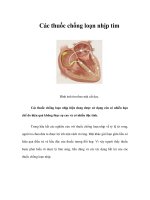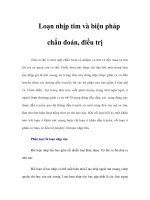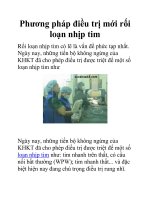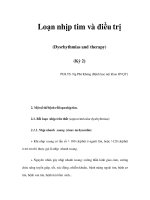Công Phạt Loạn Nhịp Tim của Thuốc Dolasetron pdf
Bạn đang xem bản rút gọn của tài liệu. Xem và tải ngay bản đầy đủ của tài liệu tại đây (89.48 KB, 6 trang )
Công Phạt Loạn Nhịp Tim của
Thuốc Dolasetron
Bài này nói về một trong những thuốc trong mộṭ họ thuốc (family) rất
thường dùng (hàng ngày) trong oncology để control NV (nausea and
vomiting).
Thật sự đây là một họ thuốc xứng đáng là breakthrough (phá nghẽn)
cho NV, vì trước đó, các thuốc khác không hiệu quả bằng.
Warnings (Cảnh báo) này đáng nhớ về torsade de pointes và QT-
prolongation.
Về hypomagnesemia, complication này thường thấy trong khi dùng
patinum-based chemotherapy (tubular wasting). Các descriptions v/v này bắt
đầu xuất hiện khoảng đầu 1980, và không có gì mới, nhưng có thể rất
nghiêm trọng (chính : cardio : arrhythmia, neuro : seizure).
(note : nhiều bnhân của tôi đã chữa khỏi ung thư, nhưng hồi đó dùng
CisPlatinum (hay carboPlat) và rồi phải uống Magnesium - replacement -
suốt đời).
FDA Warns Against Injection Dolasetron Due to Risk for Heart
Arrhythmias
Emma Hitt, PhD
Authors and Disclosures
Posted: 12/17/2010
December 17, 2010 — Dolasetron mesylate (Anzemet; Aventis
Pharmaceuticals) should no longer be used for the prevention of
chemotherapy-induced nausea and vomiting because of an increased risk for
cardiac arrhythmias, the US Food and Drug Administration (FDA)
announced today.
New data from a manufacturer study requested by the FDA
demonstrate that dolasetron injection can increase the risk for potentially
fatal torsade de pointes and has been linked to a dose-dependent
prolongation of the QT, PR, and QRS intervals on electrocardiogram.
"The FDA previously noted cardiovascular safety concerns which
suggested [dolasetron] could cause QT prolongation, which can lead to a
serious and sometimes fatal heart rhythm called torsade de pointes,"
according to the data summary accompanying the FDA's safety
announcement.
A randomized, placebo-controlled, crossover trial was conducted in
80 healthy adults and found that the difference in QT interval (corrected by
using Fridericia's formula) compared with placebo was 14.1 ms and 36.6 ms
for the 100-mg and 300-mg doses of dolasetron, respectively. Prolongation
of the PR and QRS interval was also noted in patients receiving dolasetron
in the same study on day 4.
"Based on exposure-response analyses, QT, QRS, and PR interval
prolongations appear to be associated with higher concentrations of
Anzemet's active metabolite, hydrodolasetron," the FDA concludes.
According to the data summary, patients at "particular risk for serious
abnormal rhythms are those with underlying structural heart disease and
preexisting conduction system abnormalities, the elderly, patients with sick
sinus syndrome, patients with atrial fibrillation with slow ventricular
response, patients with myocardial ischemia or patients receiving drugs
known to prolong the PR interval (such as verapamil) and QRS interval
(such as flecainide or quinidine)."
The data showing prolonged QT interval in adults were extrapolated
to a pediatric population using modeling and simulation, and interval length
was also predicted to be longer with its use for chemotherapy-induced
nausea and vomiting in this setting.
The FDA advises that healthcare professionals should correct for
hypokalemia and hypomagnesemia before administering this agent and that
these electrolytes should be monitored after administration, as clinically
indicated.
No dose adjustment is necessary for renally impaired patients,
hepatic-impaired patients, or the elderly; however, certain patients should be
monitored with electrocardiogram, including those with congestive heart
failure, with bradycardia, with underlying heart disease, the elderly, and
patients who are renally impaired.
The warning only applies to the injection form and not the tablet form
of dolasetron. The risk of developing an abnormal heart rhythm with the oral
form of this drug is less than that observed with the injection form, although
a stronger warning about this potential risk is being added to the warnings
and precautions sections of the dolasetron tablet label.
The FDA also emphasizes that the notice only applies to the use of
dolasetron in chemotherapy-induced nausea and vomiting. At a lower dose,
such as that used for postoperative nausea and vomiting, this agent is less
likely to impair the electrical functioning of the heart and cause arrhythmia,
and the injection form may still be used for this indication.
More information about today's announcement is available on the
FDA Web site.
NTM
Disclaimer: bài này qúy vị có thể phổ biến tự do, không cần xin phép
tác giả (Nguyễn Tài Mai), chỉ cần đề: bài do BS Nguyễn Tài Mai, đăng trên
diễn đàn y sĩ ngày 17 tháng 12 năm 2010 (tôi không giữ lại bản đã viết, cho
nên nếu có câu hỏi xin kèm bài này để dẫn chứng). Việc chữa bệnh từng
bệnh nhân riêng biệt dĩ nhiên hoàn toàn tùy thuộc y sĩ điều trị, y sĩ máu, y sĩ
ung thư của trường hợp đó.
Bs Nguyễn tài Mai









